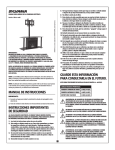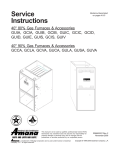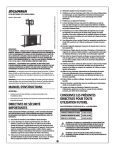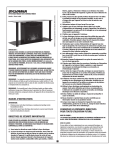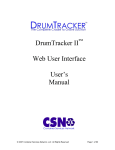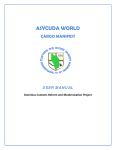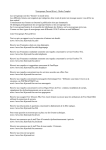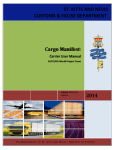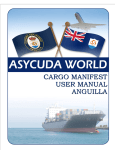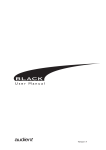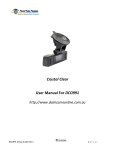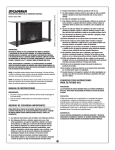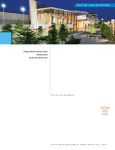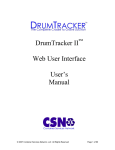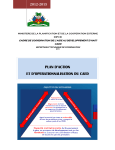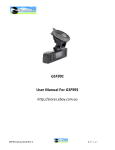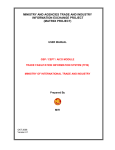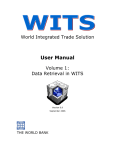Download Manifest User Manual - Grenada Customs & Excise Division
Transcript
ASYCUDA WORLD CARGO MANIFEST USER MANUAL Grenada Customs ASYCUDA Upgrade Project 2|P a ge ASYCUDA World Cargo Manifest User Manual Customs ASYCUDA Upgrade Project Table of Contents 1. Foreword………………………………………………………………….....3 2. Introduction………….. .………………………………………...……..........4 3. How to create a Manifest…………………………………………….……...5 4. How to add Bill of Lading to manifest…………………………...…………7 5. How register a manifest…………………………………..………....……...11 6. How to amend a manifest……………………………………..……...…….13 7. How to amend a Bill of Lading …………………………………….……...14 8. Excess & Shortage Procedure……………………………..……….……....17 9. How to print a Manifest and B/L…………...…………………...………....18 10. How to “degroup” a Master B/L………………………………..….……...20 11. Fast Cargo Integration…………………………………………...………................23 12. Acknowledgements.....................................................................................26 ASYCUDA World Cargo Manifest User Manual Customs ASYCUDA Upgrade Project FOREWORD The implementation of ASYCUDA World in Grenada, Carriacou and Petite Martinique is a significant and historic moment for the Customs and Excise Department of which I am honoured to be a part. Upgrading of the IT system is important to the improvement of the Department’s operations as it continues to strive towards providing effective and efficient service. ASYCUDA World is being introduced on a phased basis, beginning with the Cargo Manifest Module. On May 30, 2011 the Department will be taking its first milestone step in the process; when the Cargo Manifest Module fo r the Port o f St. George’s will be introduced. Lat er , t he Ma ni fe st Mo du le w i l l be expanded gradually to t he other Ports; namely Grenville, H il ls bo ro ugh and Maurice Bishop International Airport. The other modules will be introduced by the end of this year, with the full roll out of the system being scheduled for July 2012. This manual is presented in a user friendly manner with written instructions and graphic illustrations to ensure that persons who interact with the system are both knowledgeable and comfortable. It is intended to complement the hands-on training t hat will be provided by the ASYCUDA Project Team and will serve as a permanent record for future reference. I urge you to closely follow the instructions contained therein and to move quickly to become familiar with these new requirements. The members of the ASYCUDA Project Team are available to assist you through this transition period and will do everything possible to deal with any challenges that may arise. We anticipate that there may be some minor hitches during the transition process, and we appeal to you to exercise patience and understanding as every effort will be made to minimize any negative outcomes. This engagement should be seen as an opportunity for Customs and the general trading community to f o r g e partnerships, which can result in enhanced trade facilitation that can make a meaningful contribution towards the development of our country. I look forward to your support and cooperation. Comptroller of Customs Carlyle Felix ASYCUDA World Cargo Manifest User Manual Customs ASYCUDA Upgrade Project INTRODUCTION The Grenada Customs and Excise Department is very pleased and enthusiastic to launch its “ASYCUDA WORLD – CARGO MANIFEST USER MANUAL”, thereby maximising the benefits to the Trading Community and more specifically, Cargo Carriers, Carrier agents and Cargo Consolidators in Grenada, Carriacou and Petite Martinique. This User Manual is intended to provide our stakeholders with a series of very detailed instructions for preparation and submission electronic copies of cargo manifest to the Customs and Excise Division. Great efforts and sacrifices have been made to ensure that the instructions contained therein a r e la id o u t i n a s e q u e n t ia l ma n n e r a nd g r a p hic a l i l lu s t r at io n s ha ve be e n i nc lu d e d fo r e a ch s t e p o f t he p r o c e s s involved in storing and registering a cargo manifest on the Automated System for Customs Data (ASYCUDA). Section IV of the Draft Customs Regulations and Section IV f the Draft Customs Bill, requires that the Master of every vessel arriving at a customs port from any place outside of Grenada, or carrying goods brought in that vessel from a place outside of Grenada, and not yet cleared on importation, to deliver a report in such form and manner and containing such particulars as the Comptroller of Customs may direct. In keeping with this authority the Comptroller of Customs has directed that the instructions contained in this user manual will form part of the reporting requirements for vessels arriving from any place outside of Grenada. Please note that the normal arrival procedures will continue until such time that the Comptroller has determined otherwise. These instructions will take effect as of May 30, 2011 and will remain in force until further notice. ASYCUDA World Cargo Manifest User Manual Customs ASYCUDA Upgrade Project 1. CREATING A NEW MANIFEST Upon receipt of a paper manifest (hard copy), all the relevant information or data must be loaded into the ASYCUDA database to create an Electronic Manifest (soft copy). The Manifest gives a description of the vessel or aircraft transporting the goods and provides a summary of consignments. The following steps and images will show you how it is done. Step 1 Log in to ASYCUDA with your user name and password Step 2 Open Document library Step 3 Inside the Document Library, Click on the ASYCUDA Button to expand the menu Then click On the Cargo Manifest Button Expanding the menu 5|P a ge ASYCUDA World Cargo Manifest User Manual Customs ASYCUDA Upgrade Project Right click on Manifest, Select New The Manifest Screen will open Input all necessary data in the required fields. Mandatory fields will turn red if there is no data or selection. Data is to be entered manually or using the drop down menu. Remember that certain fields such as the Office code, voyage number, and date of departure, are the key identifying fields needed for storing and retrieving a manifest. Step 4 Verify and Storing Data. After all required data or information is entered, the document must be verified and saved (stored). To verify the document click on the icon. If there are errors, an error message(s) will be displayed. Please make the necessary corrections and verify again. To save the document click on the icon. 6|P a ge ASYCUDA World Cargo Manifest User Manual Customs ASYCUDA Upgrade Project 2. ADDING BILLS OF LADING TO A MANIFEST Step 1 Bills of Lading (B/L) can be captured in two ways Option 1 After the manifest has been stored or saved. A box will appear that matches the manifest stored. To add a Bill of Lading (B/L) to the manifest, Select the forward button as indicated by the arrow. This selection will take you to another box. To continue, select the second option. Then select yes to open a new Bill of Lading (B/L). The BoL screen on manifest will appear. Click on the Add Bol Icon as shown. Then select Yes to open new Bill of Lading. 7|P a ge ASYCUDA World Cargo Manifest User Manual Customs ASYCUDA Upgrade Project Option 2 Capture a Bill of Lading by the using the following path: From the Document Library select ASYCUDA. Then Select Cargo Manifest. Right Click on Waybill. Select New. 8|P a ge ASYCUDA World Cargo Manifest User Manual Customs ASYCUDA Upgrade Project This will generate a new Manifest – Waybill form. Note: Option 1 will open a B/L with information from the general manifest, however Option 2 will open a blank B/L. Step 2 Input data into Bill of Lading (Waybill). Enter data manually or choose from the drop down menu. When all data is complete, cursor will return to the first field of Bill of Lading (Waybill). Note: Data that was keyed into the general manifest segment will be displayed in the relevant fields of the Bill of Lading. Step 3 Add Container information to B/L if there are any in consignment. Select the Containers tab at the bottom of the screen. Fill in all required data indicated in “Manifest List of description guide” then click on the add Container icon on the menu bar. 9|P a ge ASYCUDA World Cargo Manifest User Manual Customs ASYCUDA Upgrade Project Repeat the same steps to add any additional containers for this consignee. Step 4 Verify documents to check for errors Verify the document by clicking the verify icon menu bar. on A message will appear indicating the document has been verified. 10 | P a g e ASYCUDA World Cargo Manifest User Manual Customs ASYCUDA Upgrade Project Step 5 Store documents to add it to the manifest. Click on the store icon on the menu bar as indicated by arrow. Bill of Ladings will be automatically attached to manifest. 3. REGISTERING A MANIFEST Step 1 Find a manifest using the manifest finder. Find a manifest by using the following path: From the Document Library Expand the ASYCUDA menu 11 | P a g e ASYCUDA World Cargo Manifest User Manual Customs ASYCUDA Upgrade Project Select Cargo Manifest Right click on Manifest Select Find To locate a particular manifest use the selection criteria and then click on the magnifier at the bottom of the screen or just click on the magnifier to obtain an entire list of manifests. Step 2 12 | P a g e ASYCUDA World Cargo Manifest User Manual Customs ASYCUDA Upgrade Project Register Manifest. A manifest can be registered in two (2) ways Option 1 From the manifest finder, right click on the manifest required and click Direct Register in the menu. Option 2 After selecting required manifest, click on the Register icon in the menu bar of the manifest. Note: a message will appear indicating the manifest has been registered. 4. AMENDING A MANIFEST Step 1 Use manifest finder to locate manifest. Follow steps in 3. Registering a manifest (Step 1). Right click on the desired manifest and click on Modification in the drop down menu. N.B. A Manifest can only be modified by Customs after being 13 | P a g e ASYCUDA World Cargo Manifest User Manual Customs ASYCUDA Upgrade Project registered, however, amendments can be made to its Bills of Lading. Step 2 After making amendments, save changes. Click on the Save Changes icon in the menu bar. Note: (1) Amendments can only be made to the Bill of Lading section on the manifest. (2) Once amended, manifest can be registered by clicking on the (Register Icon) in the menu bar. 5. AMENDING A BILL OF LADING (BoL) Step1 Find the Bill of Lading (BoL) to be amended. Bills of Lading can be located in two ways. Option 1 From the opened manifest click the BoL button menu at bottom of screen. Note: A list of Bills of Lading attached to the manifest will appear on the screen. 14 | P a g e ASYCUDA World Cargo Manifest User Manual Customs ASYCUDA Upgrade Project Next, right click on desired Bill of Lading Choose Modification from the drop down menu which will open the manifest. Make amendments and save changes using the Save Changes Icon . Option 2 Find the Bill of Lading using the following path: - From the document library, Select ASYCUDA Then Click on the Cargo Manifest Icon to expand the menu 15 | P a g e ASYCUDA World Cargo Manifest User Manual Customs ASYCUDA Upgrade Project Right Click on Way Bill, then select Find. Use criteria options on the finder to locate the specific B/L. Or Click on the finder and select the desired B/L from the list. Make amendments and save changes. 6. EXCESS AND SHORTAGES 16 | P a g e ASYCUDA World Cargo Manifest User Manual Customs ASYCUDA Upgrade Project Excess and Shortages can be handled in two ways. Option 1 Access desired Bill of Lading from the manifest. Right click on desired Bill of Lading Select Excess & Shortage from the drop down menu. Or Option 2 Use the finder to locate the Bill of Lading On the finder, right click on desired waybill Select Excess & Shortages from drop menu. Note: This will open the Bill of Lading and will only allow you to amend the remaining packages & remaining gross mass option. Make the necessary amendments. Deduct from remaining packages and gross mass if amending shortages or add to quantity if amending excesses. Note: Changes can only be made to the remaining packages and gross weight. 17 | P a g e ASYCUDA World Cargo Manifest User Manual Customs ASYCUDA Upgrade Project Save changes by selecting the Save Changes Icon in the menu bar. All amendments to a registered manifest must be done within the time frame specified in the Customs & Excise Act. Note: Changes must be saved before exiting Bill of Lading 7. HOW TO PRINT A MANIFEST & BILLS OF LADING Step 1 Locate the print option in document library By using the following path: From the document library, Select ASYCUDA Click on Cargo Manifest to expand the menu Click on Print Right click on Manifest and Waybill Select Print 18 | P a g e ASYCUDA World Cargo Manifest User Manual Customs ASYCUDA Upgrade Project Step 2 Fill in required data and print. Fill in the Office Code, Voyage No. and Date of Departure of the Manifest Select the Printer Icon in the men bar. Note: Manifest will show as a PDF file for printing Step 3 To print individual Bills of Lading, use the finder as shown. Select the Print option in the menu bar as indicated by the red arrow. 8. HOW TO “DEGROUP” OR BREAKDOWN A MASTER BILL OF LADING 19 | P a g e ASYCUDA World Cargo Manifest User Manual Customs ASYCUDA Upgrade Project To allow for customs clearance a Master Bill of Lading must first be split or de-grouped to the level of the individual consignee. “De-grouping” can be done in two (2) ways. Option 1 – For Carrier Agents From the opened manifest select BoL button to go to the list of Bills of Ladings (B/Ls). Select the desired Mater Bill of Lading (MST) Click on the add Bol icon on the menu bar as indicated by arrow. A prompt will pop up on screen, Select to add a new Bill of Lading to the Master Bill. Fill in the B/L reference number and all other mandatory data and then store . Note: Previous document (Master B/L number) is automatically added to the new B/L when degrouped from Master Bill of Lading. Option 2 – For Consolidators 20 | P a g e ASYCUDA World Cargo Manifest User Manual Customs ASYCUDA Upgrade Project A consolidator will receive a Master Bill of Lading from the agent; the consolidator will then use the information from this B/L to create house bills for his individual clients/consignees. To create new Bills of Lading follow this path: From the Document Library, select ASYCUDA Then click on the Cargo Manifest icon to expand the menu. Right click on Waybill, then select New. (This option will open a blank waybill). Insert the Master Bill of Lading number, Date of Departure, Voyage number and Office Code to link the new B/L to the Master Bill of Lading. Use “Manifest List of descriptions form” as a guide to complete all mandatory data then Store . 21 | P a g e ASYCUDA World Cargo Manifest User Manual Customs ASYCUDA Upgrade Project A prompt will appear indicating that the document has been stored. To continue degrouping (add another B/L) select the forward icon. This will take you to another prompt. Select the third option to add another Bill of Lading to your Master Bill of Lading. After preparing all the House Bills (degrouping) for a particular Master Bill of Lading, the consolidator should inform the Agent/Carrier to validate the “Degroupage”. To validate the “degroupage” the Agent will use the manifest or waybill finder to locate the particular Master Bill of Lading. Right click on the desired B/L. Select Validate Degroupage. A pop up will appear indicating the Validation is done. 9. FAST CARGO INTEGRATION (FCI) This option allows the user to load or import XML files (previously generated from the carriers system into ASYCUDA). 22 | P a g e ASYCUDA World Cargo Manifest User Manual Customs ASYCUDA Upgrade Project From the document library, Select ASYCUDA Click on the Fast Cargo Integration Icon to expand. Select the Manifest/Waybill Integration Option. Note: “Manifest/Waybill Integration” option in the library is for use by the Carrier Agents and “Degroupage Integration” is for use by the consolidator. Click on the Select XML File Icon to find desired manifest. Select the XML File (Manifest) required. Click Open to generate manifest. 23 | P a g e ASYCUDA World Cargo Manifest User Manual Customs ASYCUDA Upgrade Project Click on the Check Xml file icon on the menu bar to Click Ok in the check done box when it appears. Note: Manifest information and waybill summary is automatically imported into the document if all data is correct. Click on the Verify and Save Icon as indicated to complete the process. A prompt will appear on screen indicating a successful transaction. If there is an error in the integration, the system will indicate as shown below. A PDF file will open to show the type of error. The error may be Technical (System Error) or Functional (incorrect data input). 24 | P a g e ASYCUDA World Cargo Manifest User Manual Customs ASYCUDA Upgrade Project Click on to open the file. A prompt will appear on screen (PDF Export). Click on to read error message. Note: Technical errors should be referred to the System Administrator and Functional errors should be corrected by the user. To retrieve a generated manifest, From the Manifest finder input the office code, voyage number and date of departure as the search key. Right click and select the view option to see the generated manifest or select Direct Register to register the manifest. ACKNOWLEDGEMENTS The Customs ASYCUDA World Project team hopes that this manual has been helpful in assisting you to complete, store and register Cargo Manifests, generate Bills of Lading and “Degroup” Master B/Ls using the ASYCUDA Cargo Manifest Module. 25 | P a g e ASYCUDA World Cargo Manifest User Manual Customs ASYCUDA Upgrade Project To the Carrier Agents we certainly hope that the Fast Cargo Integration (FCI) Module has been of great help in integrating previously generated manifest in XML format from the Carrier systems to ASYCUDA. The ASYCUDA World Project Team expresses its appreciation for your support and participation. Your cooperation will guarantee the success of this venture as your role and responsibilities is critical to the declaration and cargo clearance process. We would like to take this opportunity to acknowledge the contributions of the following agencies without whose involvement and support, ASYCUDA World in Grenada, Carriacou and Petite Martinique would not have been a reality: The Government of Grenada (GOG) The Grenada Ports Authority The World Bank GIDC The United Nations Conference on Trade and Development (UNCTAD) GCIC CARTAC The Management & Staff of the Grenada Customs Department Prime Minister’s Ministry (I T Unit) The Ministry of Finance Department of Inland Revenue/VAT Unit Project Coordination Unit (PCU) Ministry of Legal Affairs GDTAC The Brokers’ Association The Traffickers’ Association Anyone seeking further information or assistance may contact members of the ASYCUDA World Project Team on: Telephone numbers: (473) 435 – 9622/23 Fax: (473) 435 – 9624 Email: Or visit us at: PWU Building (CSA), Tanteen, St. George’s GLOSSARY OF TERMS Manifest Segment 26 | P a g e ASYCUDA World Cargo Manifest User Manual Customs ASYCUDA Upgrade Project “Office Code” The Customs Office where manifest will be processed “Voyage Number” The number given by the ship or aircraft operators to a particular voyage from one point to another inclusive of all intermediate stops. “Date of Departure” The date when the ship or aircraft started its voyage. “Date of Arrival” The date when the ship arrives in the territorial limits of the country. “Place of Departure” The location or port code where the ship or aircraft started its voyage. “Place of Destination” The location or port code where the ship or aircraft arrives to discharge the transported goods. “Carrier Code” The identification code. It may be the VAT registration number. “Carrier Name & Address” The name and address of carrier. It is only mandatory when there is no carrier code. “Total Number of Bills” The count of Bills of Lading or Airway Bills included in the manifest. “Total Number of Packages” The sum of all packages for Grenada. “Total Number of Containers” The sum of all containers carrying cargo for Grenada “Total Gross Weight” The sum of all the weight of all cargo for Grenada “Mode of Transport” Recognises the means by which the goods were imported/exported into/outside the country. For example, were the goods brought into the country by air, sea or parcel post? “Nationality of Transport” The country in which the carrier is registered. 27 | P a g e ASYCUDA World Cargo Manifest User Manual Customs ASYCUDA Upgrade Project “Identity of Transport” The vessel or aircraft name “Carrier/Principle” The name of the carrier may be the same as Agent/cargo reporter “Registration Number” The reference of the document registering the vessel or aircraft. “Master Name” The name of the master of the ship or the commander of the aircraft. “Time of Arrival” The time when the vessel or aircraft arrived in the country. Bill of Lading Segment “Registration Date” The date when the vessel was registered. “Bill of Lading Reference Number” The number which uniquely identifies the bill of lading or airway bill. “B/L Type” The code which identifies the type of transport document issued (710 for House Bill of Lading, 711 for consolidated Master Bill of Lading). “Nature” The manner in which the goods will be treated. These are indicated by the codes 22 (export), 23 (import), 24 (in transit) and 28 (transhipment). “Previous Document” The reference of the master bill of lading or airway bill needed to prepare degrouped bills. “Name of Shipper/Exporter” Grenada. The name of the persons sending the goods to “Consignee” The name and address of the person or firm named in a freight contract to whom goods have been shipped or turned over for care in Grenada. “Total Number of Containers” The sum of all containers carrying goods, which belong to the bill of lading or airway bill. “Kinds of Packages” The description of the packaging of goods; cartoon, crate, drum, etc. 28 | P a g e ASYCUDA World Cargo Manifest User Manual Customs ASYCUDA Upgrade Project “Marks & Numbers” The markings that the shipper placed on the packages to identify his/her cargo. It follows no particular sequence and can be any set of words, numbers or other signs that the shipper affixes. “Total number of packages” The piece count of the packages under each bill of lading or airway bill. “Total Gross Weight” airway bill. The weight for goods under each bill of lading or “Cubic Metric Volume” The measurement of the cargo inside the container. It is not the cubic measurement of the container unless that container is full. “Description of Goods” The narrative that portrays the type of goods being transported. The description must be explicit. It must not include terms such STC (Said to Contain), clothing, tiles, food stuff, etc. Acceptable terms would be men’s leather shoes, ceramic tiles, women’s pants of cotton, rice in packages, etc. “Terms of Delivery Indicator” The narrative that describes the agreed terms between the parties. They may be FAS, FOB, C&F, etc. “Location Code” The process used by the port to identify the exact place in the port or shed where the goods can be found. “Freight Amount” The cost of freight. “Freight Currency” The actual currency in which the payment for freight is quoted. “Notify/Code Name” The address or contact number of a person other than the consignee. “Location” The place where goods are stored for delivery, may be a transit shed. “Value Declared for Customs” The worth of the goods which the importer or exporter intends to declare to customs. “Currency Declared for Customs” The actual currency in which the payment for transport is quoted. 29 | P a g e ASYCUDA World Cargo Manifest User Manual Customs ASYCUDA Upgrade Project “Value Declared for Insurance” The cost of the insurance. “Currency Code for Insurance Value” The actual Currency in which the payment for insurance is quoted. “Number of Seals” The count of the seals affixed to the container or package. “Marks of Seals” The markings that identifies the seals placed on the containers or packages. “Sealing Party Code” The code used by the sealer to identify who sealed the container or package. “Information” Any other relevant information which the carrier or agent deems necessary. Container Segment “Container Reference” The container identification number. Four letters for container owner, six digit container serial number, and check digit. “Number of Packages” The number of packages in the container. “Type of Container” The container type code (e.g. 20BU, 40BK) states the size and type of container. “Empty/Full Indicator” Describes how much space is occupied by goods inside of the container. (LCL, FCL, FCX). “Container Goods Description” The description of goods in the container. “Gross Mass” The Gross Mass for good in the container in kg. “Marks/Seals2 The container 2nd seal number. “Sealing Party” The code used to identify who sealed the container (SH, TO, CU). “Temp. Min” The minimum temperature for container, this field is mandatory for reefer container. “Temp. Max” The maximum temperature for container, this field is mandatory for reefer container. 30 | P a g e ASYCUDA World Cargo Manifest User Manual Customs ASYCUDA Upgrade Project “Humidity” The humidity level for reefer container. “Dangerous Goods Code” The dangerous goods code (UNDG) 31 | P a g e































